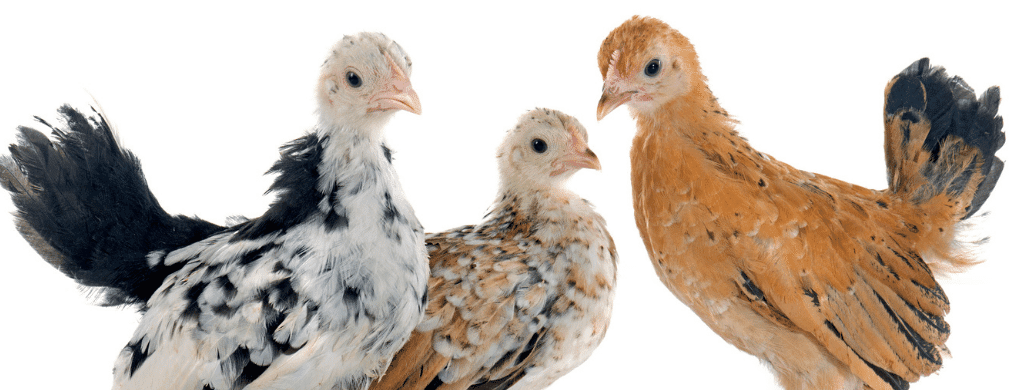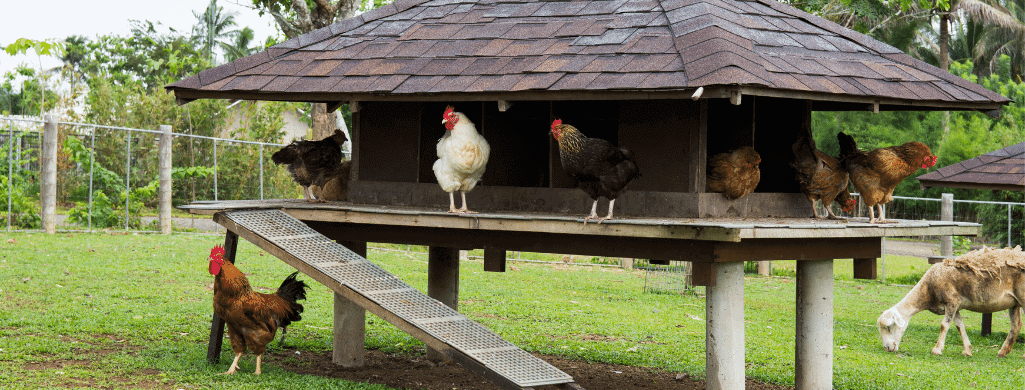When considering what breed of chicken to add to your backyard flock, it’s important to consider how different poultry gets along with each other.
Can you keep Seramas with standard breeds?
Serama hens and roosters can live with other chickens as long as they are not aggressive. Seramas do best when kept with other small or true bantam breeds rather than larger birds.
Keep reading to learn more about how Seramas do in mixed flocks and how to limit conflict within a flock.

Table of Contents
ToggleKeeping Seramas in a Mixed Flock
The Serama chicken is a friendly, docile breed. They are unlikely to be aggressive or bully other breeds.
Having them in a mixed flock depends on the breeds you are keeping with them. Since Serama chickens are small birds, they do best with other small, Bantam, or docile breeds.
Aggressive breeds like Buckeyes or Cornish are likely to pick on them.
Your best bet for a mixed flock is to keep them with a Silkie or Japanese Bantam. They are also small and have similar temperaments.
When introducing new chickens into your flock, keep them separate for at least a week to check for signs of disease or parasites.
You don’t want it to spread unchecked through the rest of the flock.
All chickens have a pecking order, regardless of size, so slowly introduce new birds to the flock. Newcomers always start at the bottom of the pecking order, so they are at risk of being bullied.
To reduce the chances of other chickens bullying your Serama hens or roosters, ensure you have enough space for your whole flock.
Cramped chickens are more likely to lash out at each other. The same is true of hungry chickens.
Also, Serama chickens tend to be a bit broody, which only amplifies the cramped issue.
Further Reading: Serama chickens and brooding
Serama Chicken Size
Seramas are the tiniest of breeds of chicken.
These Malaysian bantams only weigh between 13 and 19 ounces. When it comes to height, they are only 6 to 10” inches tall.
Their tiny bodies are shaped like a V. They have excellent posture. They look like they are always standing at attention.
There are four weight classes for the Serama breed standard.
| Class | Rooster Weight Range | Hen Weight Range |
|---|---|---|
| Micro | up to 13 ounces | up to 8 ounces |
| A | up to 13 ounces | up to 12 ounces |
| B | up to 16 ounces | up to 15 ounces |
| C | up to 19 ounces | up to 19 ounces |
Serama chickens come in a variety of colors, including white and black. Some Seramas have normal feathers, but there are also silky and frizzle feathered versions of this breed.

Ideal Coop Sizes for Your Chickens
If you integrate Seramas with other breeds, ensure you have enough space for them to be happy and get along.
Larger chickens need at least 4’ square feet of space in the coop, 8’ square feet of space in a run, and 1’ foot of perch space.
This is per bird, so multiply by the number of chickens you have.
Smaller chickens, including Seramas and other Bantam breeds, don’t need quite as much space.
They need 1-2’ square feet per bird for the coop and 4’ square feet for the run. Always make sure to have more space rather than less.
Seramas like to fly, so provide different heights of perches for them. They can fly up to safety if a larger chicken is picking on them.
To cut down fighting over food, ensure your birds have enough food and constant access to fresh water.
Special Care for Seramas
Whenever you have small birds like Seramas, they are at greater risk of being targeted by flying predators, such as hawks and owls. To prevent this, make sure their runs are covered.
Small breeds have a faster metabolism and a larger surface area ratio. This results in them becoming cold quickly, requiring extra care to ensure they are warm enough.
It is good practice, in general, to make sure no drafts are getting into the coop, but this is especially important for small breeds.
Using reed matting to cover the inside of the coop helps with this. It also helps prevent small birds from getting caught in any mesh around the coop.
Serama chickens also require special attention to their legs and feet. If it is wet, damp, or muddy, this can lead to frostbitten legs when it is colder.
Further Reading: Are Serama Chickens Cold Hardy?
Ideally, give them a coop run to move around in. This gives each area time to dry and regrow before the chickens are placed there again.

Serama Egg Production
Even though Serama hens are tiny, they are good egg layers. Of course, their eggs are much smaller than the eggs you get at the grocery store.
Larger chicken breeds lay larger eggs and are more common for egg production.
One Serama hen will lay four to five eggs per week on average. This comes out to 180 to 200 eggs in a year. These tiny eggs are light cream or brown.
An average egg is about five times larger than these Serama eggs.
Hens begin laying around 5 months old. Unlike many other breeds, they are year-round layers. Also, unlike other breeds, they lay more during the winter months.
This is specifically from November through February.
This breed is also broody, so don’t be surprised to find them spending a lot of time in their nesting boxes. Hatching eggs is a little hard for them, though.
They can sit on only 4 or 5 eggs because their bodies are small.
Unfortunately, this affects their hatch rate if the hen attempts to incubate more eggs. Luckily, though, they have a shorter incubation period.
Serama eggs hatch at around 19-20 days instead of the 21 days of the average chicken.
For more details, check out our complete guide to Serama chicken eggs.
Other Small Breeds
Serama bantams are the smallest breed in the world. As we discussed, keeping them with other small breeds is best.
Here is a list of some other small breeds to mix in with the flock:
- Dutch Bantam
- Appenzeller Bantam*
- Old English Game
- Japanese Bantam
- Belgian D’Anvers
- Booted Bantam
- Rosecomb
- Sebright
*All of these are recognized by the American Poultry Association except the Appenzeller.
How useful was this post?
Click on a star to rate it!
We are sorry that this post was not useful for you!
Let us improve this post!
Tell us how we can improve this post?
